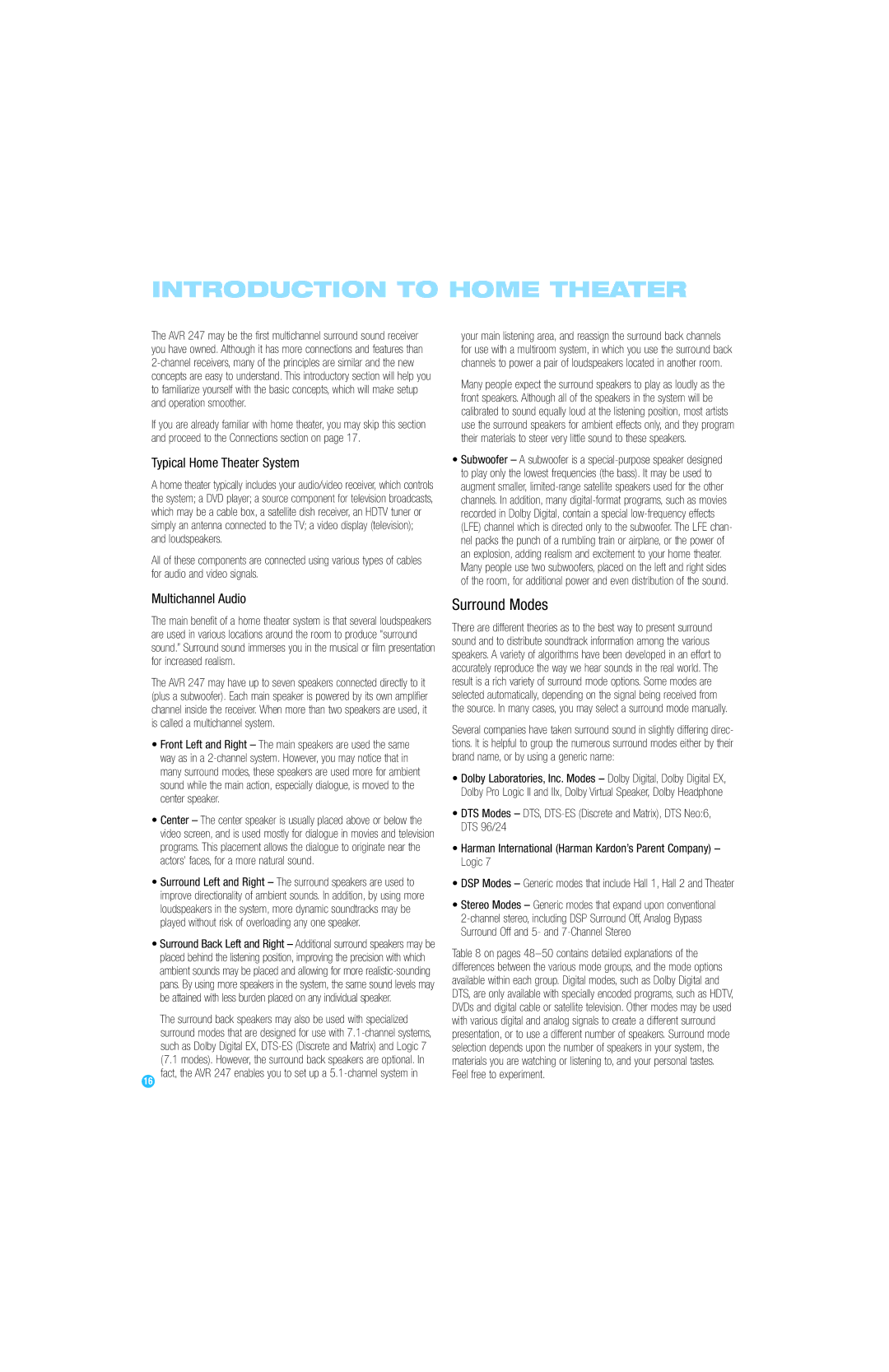
INTRODUCTION TO HOME THEATER
The AVR 247 may be the first multichannel surround sound receiver you have owned. Although it has more connections and features than
If you are already familiar with home theater, you may skip this section and proceed to the Connections section on page 17.
Typical Home Theater System
A home theater typically includes your audio/video receiver, which controls the system; a DVD player; a source component for television broadcasts, which may be a cable box, a satellite dish receiver, an HDTV tuner or simply an antenna connected to the TV; a video display (television); and loudspeakers.
All of these components are connected using various types of cables for audio and video signals.
your main listening area, and reassign the surround back channels for use with a multiroom system, in which you use the surround back channels to power a pair of loudspeakers located in another room.
Many people expect the surround speakers to play as loudly as the front speakers. Although all of the speakers in the system will be calibrated to sound equally loud at the listening position, most artists use the surround speakers for ambient effects only, and they program their materials to steer very little sound to these speakers.
•Subwoofer – A subwoofer is a
Multichannel Audio
The main benefit of a home theater system is that several loudspeakers are used in various locations around the room to produce “surround sound.” Surround sound immerses you in the musical or film presentation for increased realism.
The AVR 247 may have up to seven speakers connected directly to it (plus a subwoofer). Each main speaker is powered by its own amplifier channel inside the receiver. When more than two speakers are used, it is called a multichannel system.
•Front Left and Right – The main speakers are used the same way as in a
•Center – The center speaker is usually placed above or below the video screen, and is used mostly for dialogue in movies and television programs. This placement allows the dialogue to originate near the actors’ faces, for a more natural sound.
•Surround Left and Right – The surround speakers are used to improve directionality of ambient sounds. In addition, by using more loudspeakers in the system, more dynamic soundtracks may be played without risk of overloading any one speaker.
•Surround Back Left and Right – Additional surround speakers may be placed behind the listening position, improving the precision with which ambient sounds may be placed and allowing for more
The surround back speakers may also be used with specialized surround modes that are designed for use with
fact, the AVR 247 enables you to set up a
16
Surround Modes
There are different theories as to the best way to present surround sound and to distribute soundtrack information among the various speakers. A variety of algorithms have been developed in an effort to accurately reproduce the way we hear sounds in the real world. The result is a rich variety of surround mode options. Some modes are selected automatically, depending on the signal being received from the source. In many cases, you may select a surround mode manually.
Several companies have taken surround sound in slightly differing direc- tions. It is helpful to group the numerous surround modes either by their brand name, or by using a generic name:
•Dolby Laboratories, Inc. Modes – Dolby Digital, Dolby Digital EX, Dolby Pro Logic II and IIx, Dolby Virtual Speaker, Dolby Headphone
•DTS Modes – DTS,
•Harman International (Harman Kardon’s Parent Company) – Logic 7
•DSP Modes – Generic modes that include Hall 1, Hall 2 and Theater
•Stereo Modes – Generic modes that expand upon conventional
Table 8 on pages
16
